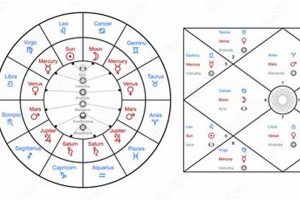A depiction of the celestial positions at the precise moment of an individual’s birth, calculated according to the principles of Vedic Astrology, forms the basis of this ancient practice. This celestial snapshot, often visualized as a circular diagram divided into twelve houses, represents the planetary influences believed to shape personality, life path, and potential experiences. For example, the placement of the Sun might indicate core identity, while the Moon’s position could reveal emotional tendencies.
This system serves as a tool for self-discovery and understanding, offering potential insights into strengths, weaknesses, and karmic patterns. By examining the interplay of planetary energies within the birth chart, practitioners aim to guide individuals towards greater self-awareness and informed decision-making. Rooted in ancient Indian astronomical traditions, this practice continues to resonate with those seeking a deeper comprehension of themselves and their place within the cosmos.
Further exploration of specific planetary placements, house interpretations, and astrological combinations can provide a more nuanced understanding of this complex and fascinating system.
Tips for Utilizing Astrological Insights
These suggestions offer guidance on approaching interpretations derived from a Vedic astrological birth chart analysis.
Tip 1: Consult with a Qualified Practitioner: Accurate chart interpretation requires extensive knowledge and experience. Seeking guidance from a reputable Vedic astrologer is recommended for a comprehensive analysis.
Tip 2: Focus on Self-Development: View astrological insights as opportunities for growth and self-improvement rather than fixed predictions. This empowers individuals to navigate life’s challenges with greater awareness.
Tip 3: Consider the Whole Chart: Avoid isolating individual planetary placements. A holistic approach considers the interplay of all elements within the chart for a more nuanced understanding.
Tip 4: Integrate Astrological Knowledge with Practical Action: While astrological insights can offer valuable perspectives, they are most effective when combined with proactive efforts and informed decision-making.
Tip 5: Maintain an Open Mind: Approach astrological interpretations with a balanced perspective. Avoid rigid interpretations and embrace the potential for growth and change.
Tip 6: Respect Individual Differences: Recognize that birth charts are unique to each individual. Avoid generalizations and appreciate the diverse expressions of astrological influences.
By incorporating these tips, individuals can gain a deeper appreciation for the potential benefits of astrological study and apply this knowledge to enhance self-understanding and personal growth.
This understanding serves as a foundation for further exploration into the rich tapestry of Vedic astrological wisdom.
1. Planets
Planets form the core of Vedic astrological interpretation. Their placements within the natal chart are considered key indicators of an individual’s personality traits, strengths, weaknesses, and karmic tendencies. Understanding planetary influences is crucial for deciphering the complexities of a birth chart.
- Luminaries: Sun and Moon
Often referred to as luminaries, the Sun and Moon hold significant weight in Vedic astrology. The Sun represents core identity, vitality, and self-expression, while the Moon governs emotions, instincts, and the inner world. For example, a Sun in Leo might suggest a charismatic and expressive individual, whereas a Moon in Pisces could indicate heightened sensitivity and empathy. These placements offer fundamental insights into an individual’s basic nature.
- Inner Planets: Mercury, Venus, and Mars
Mercury, Venus, and Mars are considered inner planets, influencing communication, relationships, and action, respectively. Mercury’s placement indicates intellectual style and communication patterns. Venus represents love, beauty, and artistic inclinations. Mars signifies energy, drive, and assertiveness. An example would be Venus in Libra potentially indicating a strong desire for harmony and balance in relationships. The interplay of these planets contributes to an understanding of interpersonal dynamics and personal motivations.
- Outer Planets: Jupiter and Saturn
Jupiter and Saturn, known as outer planets, represent expansion and limitation. Jupiter is associated with wisdom, luck, and opportunities for growth, while Saturn signifies discipline, responsibility, and karmic lessons. Jupiter in Sagittarius might suggest an optimistic and philosophical outlook, while Saturn in Capricorn could indicate a strong sense of duty and practicality. These planetary influences provide insights into an individual’s approach to life’s challenges and opportunities.
- Shadow Planets: Rahu and Ketu
Rahu and Ketu, referred to as shadow planets or lunar nodes, represent points of karmic intersection. Rahu signifies desires, ambitions, and areas of potential obsession, while Ketu represents detachment, spirituality, and past-life influences. Rahu in the tenth house might suggest a strong drive for career success, whereas Ketu in the fourth house could indicate a focus on inner peace and spiritual pursuits. These placements offer valuable insights into karmic patterns and evolutionary paths.
The combined influence of these planets, as depicted within the natal chart, forms a complex interplay of energies that shapes an individual’s life experiences. Understanding these planetary placements is fundamental to gaining deeper self-awareness and navigating life’s journey with greater insight. Further analysis involving planetary aspects and house placements deepens the understanding of these core planetary energies.
2. Houses (Bhavas)
Houses, also known as Bhavas, represent specific areas of life within a Vedic astrological natal chart. These twelve divisions of the chart, each associated with distinct themes, provide a framework for understanding how planetary energies manifest in various life experiences. The placement of planets within these houses indicates their influence on specific aspects of an individual’s life. For example, the tenth house (karma bhava) relates to career and public image. A strong planetary presence in this house could suggest prominence in one’s profession. Conversely, challenges in this house might indicate career obstacles. The fourth house (sukha bhava) represents home, family, and emotional security, indicating the quality of these areas based on planetary placements.
Each house holds significance, covering diverse facets of life: the first house (tanu bhava) represents self and appearance; the second house (dhana bhava) governs finances and possessions; the third house (sahaja bhava) relates to communication and siblings; the fifth house (putra bhava) signifies creativity and children; the sixth house (ari bhava) deals with health and service; the seventh house (yuvati bhava) focuses on partnerships and marriage; the eighth house (randhra bhava) concerns transformation and longevity; the ninth house (dharma bhava) relates to higher learning and spirituality; the eleventh house (labha bhava) signifies gains and aspirations; and the twelfth house (vyaya bhava) represents losses and liberation. Analyzing planetary placements within each house provides a detailed map of potential life experiences.
Understanding the interplay between planets and houses is essential for interpreting a Vedic natal chart. This knowledge provides a deeper understanding of karmic influences and potential life trajectories. While planetary placements indicate inherent energies, their expression is contextualized by the houses they occupy. This understanding empowers individuals to navigate their strengths and weaknesses with greater awareness. Further analysis of planetary aspects and sign placements enhances this understanding, offering a comprehensive picture of individual potential and karmic influences. This intricate interplay forms the basis of Vedic astrological interpretation, offering guidance for self-discovery and personal growth.
3. Signs (Rashis)
Signs, also known as Rashis, constitute the zodiacal backdrop against which planetary positions are mapped in a Vedic astrological natal chart. These twelve signs, each spanning 30 degrees of the celestial circle, provide a nuanced understanding of planetary influences by imbuing them with specific qualities. Each sign possesses distinct characteristics, influencing the expression of planets residing within them. Understanding the significance of these signs is fundamental to interpreting a Vedic birth chart.
- Elemental Qualities
Each sign belongs to one of four elements: fire, earth, air, or water. Fire signs (Aries, Leo, Sagittarius) are associated with energy, enthusiasm, and dynamism. Earth signs (Taurus, Virgo, Capricorn) represent practicality, stability, and groundedness. Air signs (Gemini, Libra, Aquarius) signify intellect, communication, and social interaction. Water signs (Cancer, Scorpio, Pisces) embody emotions, intuition, and sensitivity. A planet in a fire sign will express its energy differently than when placed in a water sign. For example, Mars, a fiery planet, in Aries, another fire sign, could indicate heightened aggression, while Mars in Pisces, a water sign, might manifest as passive aggression.
- Modalities (Gunas)
Signs are also categorized by three modalities: cardinal, fixed, and mutable. Cardinal signs (Aries, Cancer, Libra, Capricorn) initiate action and represent beginnings. Fixed signs (Taurus, Leo, Scorpio, Aquarius) symbolize stability and determination. Mutable signs (Gemini, Virgo, Sagittarius, Pisces) represent adaptability and change. These modalities influence how a planet’s energy is expressed. For instance, Saturn, a planet of structure, in a fixed sign like Taurus might indicate stubborn resistance to change, while Saturn in a mutable sign like Sagittarius could signify a more philosophical and adaptable approach to life’s lessons.
- Planetary Rulership
Each sign is ruled by a specific planet, further influencing the expression of planets placed within it. This rulership adds another layer of interpretation. For example, Mercury rules Gemini and Virgo. When a planet is placed in a sign ruled by a benefic planet like Jupiter or Venus, its positive qualities may be amplified. Conversely, placement in a sign ruled by a malefic planet like Saturn or Mars might present challenges. Sun in Leo, ruled by the Sun itself, suggests a strong sense of self, while Moon in Cancer, ruled by the Moon, indicates heightened emotional sensitivity.
- Sign Interrelationships
Signs relate to each other through various astrological concepts such as aspects and house placements. These relationships add complexity and depth to chart interpretation. Certain signs are considered compatible or incompatible based on their elemental and modal qualities. A planet in a sign compatible with its own nature might function more harmoniously, while a planet in an incompatible sign could experience friction. Understanding these interrelationships provides a more nuanced understanding of the dynamics within a natal chart. For instance, a planet in Aries might clash with a planet in Cancer due to the conflicting nature of fire and water elements, respectively.
By considering the elemental qualities, modalities, planetary rulerships, and interrelationships of the signs, Vedic astrologers gain a deeper understanding of how planetary energies are expressed within an individual’s natal chart. This multifaceted approach to sign analysis contributes to a comprehensive interpretation of individual predispositions, strengths, and potential life paths. This understanding, combined with an analysis of houses and planetary aspects, completes the picture, offering valuable insights for self-awareness and personal growth.
4. Nakshatras (Lunar Mansions)
Nakshatras, also known as Lunar Mansions, represent a crucial component within Vedic astrology, offering a more granular level of analysis than the twelve zodiacal signs. These 27 (or sometimes 28) segments divide the ecliptic, each spanning 13 degrees and 20 minutes. Referencing nakshatras provides deeper insights into the nuances of planetary placements within a natal chart, enriching the interpretation of individual predispositions and life experiences. Each nakshatra possesses unique qualities, further refining the understanding of planetary influences.
- Planetary Rulers and Deities
Each nakshatra is associated with a ruling planet and a presiding deity, influencing the energy expressed through that particular segment of the ecliptic. For instance, Ashwini nakshatra is ruled by Ketu and connected to the Ashwini Kumaras, the divine healers, imbuing it with qualities of healing and service. Understanding these associations provides further insight into the specific expression of planets residing within a given nakshatra. A planet in Ashwini might manifest differently than the same planet in Bharani, ruled by Venus and linked to Yama, the god of death, which carries themes of transformation and intensity.
- Symbolism and Characteristics
Each nakshatra possesses unique symbolism and characteristics, providing further layers of meaning to planetary placements. For example, Rohini nakshatra is symbolized by a cart, representing nourishment and growth, while Ardra nakshatra is symbolized by a teardrop, associated with sorrow and purification. These symbolic representations provide deeper insights into the potential experiences and karmic patterns associated with planets placed within specific nakshatras. A planet in Rohini might indicate a focus on material prosperity, while a planet in Ardra could suggest a path of emotional transformation.
- Padas (Quarters)
Each nakshatra is further divided into four quarters, or padas, each ruled by a different sign. This finer division refines the interpretation of planetary placements by blending the qualities of the nakshatra with the characteristics of the pada’s ruling sign. This adds complexity and precision to the analysis. For example, a planet in the first pada of Ashwini, ruled by Aries, would combine the healing energy of Ashwini with the assertive nature of Aries, while a planet in the second pada of Ashwini, ruled by Taurus, might blend Ashwini’s healing qualities with Taurus’s grounded nature, emphasizing practicality and material stability.
- Gunas (Qualities)
Each nakshatra is also associated with one of the three Gunas: Sattva (purity), Rajas (activity), and Tamas (inertia). These qualities influence how the nakshatra’s energy is expressed. Sattvic nakshatras promote spiritual growth, Rajasic nakshatras encourage worldly pursuits, and Tamasic nakshatras represent inertia or stagnation. Understanding the Guna of a nakshatra provides insights into the underlying motivations and karmic tendencies associated with planetary placements within it. A planet in a Sattvic nakshatra like Pushya might indicate a focus on spiritual development, while a planet in a Rajasic nakshatra like Magha could suggest a desire for power and recognition.
By incorporating nakshatra analysis into the interpretation of a Vedic natal chart, astrologers gain a more nuanced and detailed understanding of individual predispositions, karmic influences, and potential life experiences. This deeper level of analysis complements the broader understanding provided by signs, houses, and planetary aspects, offering a comprehensive picture of individual potential. Understanding the interplay of these factors provides a powerful tool for self-discovery and personal growth within the framework of Vedic astrology. This intricate system offers profound insights into the complexities of human experience and the karmic influences shaping individual destinies.
5. Aspects (Yogas)
Planetary aspects, known as Yogas in Vedic astrology, represent angular relationships between planets within a natal chart. These relationships, formed by specific degrees of separation between planets, significantly influence the interpretation of individual predispositions and potential life experiences. Understanding these aspects is crucial for deciphering the complexities of a birth chart and gaining deeper insights into karmic patterns and individual destinies. Aspects can modify planetary influences, creating either harmonious or challenging combinations that shape an individual’s life path.
- Conjunction (Yuti)
A conjunction occurs when two or more planets occupy the same sign and degree within the natal chart. This powerful alignment blends the energies of the involved planets, creating a concentrated influence. For example, a conjunction of Venus and Mercury might indicate skill in communication and artistic expression. However, a conjunction of Mars and Saturn could create tension and frustration, requiring careful management of energies. The nature of the conjunction depends on the planets involved and their inherent qualities. Benefic conjunctions can bring good fortune and positive opportunities, while challenging conjunctions may present obstacles that require resilience and adaptation.
- Opposition (180 degrees)
An opposition occurs when planets are positioned approximately 180 degrees apart in the natal chart. This aspect creates a dynamic tension between opposing energies, often representing a need for balance and integration. An opposition between the Sun and Moon, for instance, might signify internal conflict between the conscious and subconscious desires, requiring conscious effort to reconcile these opposing forces. While oppositions can present challenges, they also offer opportunities for growth and self-awareness by highlighting areas requiring integration and compromise.
- Trine (120 degrees)
A trine occurs when planets are positioned approximately 120 degrees apart. This harmonious aspect facilitates the smooth flow of energy between planets, often indicating ease and natural talent in areas associated with the involved planets. A trine between Jupiter and Venus, for example, might suggest good fortune in relationships and financial matters. Trines represent supportive energies that contribute to overall well-being and create opportunities for growth and fulfillment.
- Square (90 degrees)
A square occurs when planets are positioned approximately 90 degrees apart. This challenging aspect creates friction and tension between planets, often representing obstacles and areas requiring conscious effort and development. A square between Mars and Saturn, for instance, might indicate frustration and delays in achieving goals, requiring discipline and perseverance to overcome challenges. While squares can be difficult, they also offer opportunities for growth and strength-building by prompting individuals to confront limitations and develop resilience.
Analyzing planetary aspects within a natal chart provides valuable insights into the interplay of planetary energies and their influence on individual characteristics and life experiences. These Yogas, formed by the specific angular relationships between planets, refine the interpretation of planetary placements and offer a deeper understanding of karmic patterns and potential life trajectories. By understanding these intricate connections, Vedic astrologers gain a comprehensive perspective on individual strengths, weaknesses, and opportunities for growth. This knowledge empowers individuals to navigate their life paths with greater awareness and make informed decisions aligned with their karmic predispositions.
6. Dasha System (Planetary Periods)
The Dasha system forms a crucial element within Vedic astrology, providing a framework for understanding the unfolding of karmic influences throughout an individual’s life. Based on the position of the Moon at the time of birth, this system outlines specific planetary periods, known as Dashas, during which particular planetary energies dominate. Analyzing these periods offers valuable insights into the timing of specific life events and experiences, providing a roadmap for navigating life’s journey within the context of a natal chart.
- Vimshottari Dasha: The Predominant Cycle
The Vimshottari Dasha, a 120-year cycle, serves as the most commonly used Dasha system in Vedic astrology. It comprises periods ruled by various planets, each with varying durations. For example, the Ketu Dasha lasts for 7 years, while the Venus Dasha extends for 20 years. These periods signify times when the energies of the ruling planet exert a prominent influence on an individual’s life, shaping experiences and opportunities. Understanding the specific characteristics of each planetary Dasha provides valuable insights into potential life events during those periods. For instance, a Jupiter Dasha might bring opportunities for growth and expansion, while a Saturn Dasha might necessitate discipline and perseverance.
- Antardashas and Pratyantardashas: Sub-Periods within Dashas
Within each major Dasha, there exist sub-periods known as Antardashas, which are further divided into Pratyantardashas. These sub-periods offer a more granular perspective on the timing of specific events and experiences within the broader context of the main Dasha. Analyzing these sub-periods provides finer details about the interplay of planetary energies and their impact on an individual’s life. For instance, a beneficial Antardasha within a challenging Dasha could offer respite or opportunities amidst difficulties. Conversely, a challenging Antardasha within a beneficial Dasha might present temporary obstacles or require adjustments to navigate potential setbacks.
- Planetary Influences during Dashas
The planetary ruler of a particular Dasha significantly influences the themes and experiences that unfold during that period. For instance, a Mars Dasha might bring energy and assertiveness, potentially leading to new initiatives or conflicts, while a Mercury Dasha might focus on communication, learning, and intellectual pursuits. Understanding the characteristics of the ruling planet provides valuable insights into potential opportunities and challenges during specific Dashas. This knowledge empowers individuals to make informed decisions and navigate life transitions with greater awareness.
- Predictive Applications of the Dasha System
By analyzing the sequence of Dashas and their corresponding planetary influences, Vedic astrologers can gain insights into the timing of significant life events. This predictive application of the Dasha system offers valuable guidance for navigating life’s journey, allowing individuals to anticipate potential challenges and capitalize on favorable opportunities. While the Dasha system does not offer deterministic predictions, it provides a framework for understanding the unfolding of karmic patterns and making choices aligned with individual predispositions and potential life trajectories. For example, a Jupiter Dasha might indicate a favorable time for marriage or career advancement, while a Saturn Dasha might present challenges that require patience and resilience.
The Dasha system, by providing a temporal dimension to the interpretation of a natal chart, enhances the understanding of karmic influences and their manifestation throughout an individual’s life. By analyzing planetary periods, Vedic astrologers offer valuable insights into the timing of significant life events and empower individuals to navigate their life paths with greater awareness. Integrating this temporal understanding with the analysis of planetary placements, signs, houses, nakshatras, and aspects provides a comprehensive and nuanced interpretation of a natal chart, offering profound insights into individual potential, karmic patterns, and the unfolding of destiny.
Frequently Asked Questions
This section addresses common inquiries regarding the interpretation and application of Vedic astrological birth charts.
Question 1: How does a Vedic astrological birth chart differ from a Western astrological chart?
Key distinctions include the Vedic system’s use of a sidereal zodiac based on fixed constellations, while Western astrology employs a tropical zodiac based on the equinoxes. This results in different planetary placements. Additionally, Vedic astrology emphasizes lunar mansions (Nakshatras) and planetary periods (Dashas) for a more nuanced analysis.
Question 2: Is Vedic astrology fatalistic?
Vedic astrology offers insights into karmic predispositions, not fixed destinies. It emphasizes free will and the potential for growth through self-awareness and informed decision-making. While the chart indicates potential challenges, it also highlights strengths and opportunities for navigating life’s complexities.
Question 3: How accurate are predictions based on a birth chart?
Accuracy depends on the expertise of the astrologer and the individual’s receptivity to self-reflection. A birth chart provides a roadmap, not a minute-by-minute itinerary. It offers valuable insights into potential life paths and empowers individuals to navigate life’s journey with greater awareness. Predictions should be viewed as probabilities, not certainties.
Question 4: Can one change their destiny as indicated in their birth chart?
Vedic astrology emphasizes the concept of karma and its influence on current circumstances. However, it also acknowledges the potential for transformation through conscious action and self-improvement. Remedial measures, such as gemstone recommendations or mantra practices, are often suggested to mitigate challenges and enhance positive influences. These measures are not guaranteed solutions but can support personal growth and transformation.
Question 5: How often should one consult an astrologer?
Consultation frequency depends on individual needs and preferences. Some seek guidance during specific life transitions, while others prefer regular consultations for ongoing support. Ultimately, the decision rests on individual circumstances and the perceived value of astrological insights.
Question 6: What are the limitations of Vedic astrological analysis?
Like any system of knowledge, Vedic astrology has limitations. It requires accurate birth data for reliable interpretation. Furthermore, the complexity of the system demands skilled interpretation to avoid misrepresentations or oversimplifications. It is crucial to approach interpretations with discernment and avoid relying solely on astrological guidance for major life decisions.
Understanding these fundamental aspects of Vedic astrological analysis encourages a balanced and informed approach to this ancient system of knowledge. It emphasizes the potential for self-discovery and personal growth through informed interpretation and application of astrological insights.
Further exploration into specific areas of interest within Vedic astrology can provide a more specialized understanding of this complex and fascinating subject.
Natal Chart Vedic Astrology
Exploration of Vedic astrological natal charts reveals a complex system for understanding individual predispositions and potential life paths. Key components, including planets, signs, houses, nakshatras, aspects, and the dasha system, offer a multifaceted framework for interpreting the interplay of celestial influences. Planetary placements within the houses and signs, modified by aspects and further nuanced by nakshatras, provide a rich tapestry of information. The dasha system adds a temporal dimension, unveiling the unfolding of karmic influences throughout life.
This intricate system offers valuable insights for self-discovery and personal growth. By understanding the language of the cosmos as depicted within a natal chart, individuals can gain a deeper understanding of their strengths, weaknesses, and karmic patterns. This knowledge empowers informed decision-making and facilitates a more conscious approach to navigating life’s journey. Further study and exploration within this rich tradition offer continuous opportunities for deeper self-awareness and a more profound understanding of the human experience within the cosmic order. It encourages continued exploration of the profound wisdom embedded within this ancient practice.







